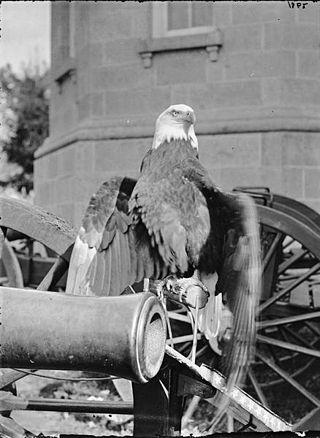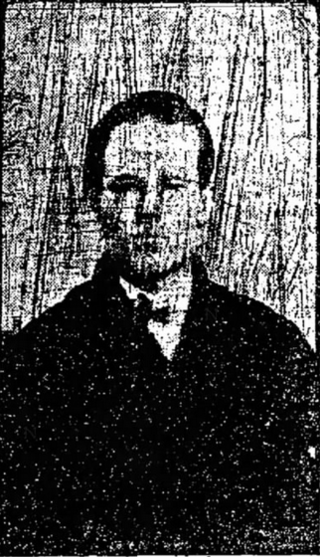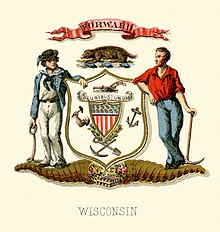
Camp Randall was a United States Army base in Madison, Wisconsin, the largest staging point for Wisconsin troops entering the American Civil War. At this camp fresh volunteers received quick training before heading off to join the Union Army. Also located on the grounds were a hospital and briefly a prisoner-of-war camp for captured Confederate soldiers.
The 15th Wisconsin Infantry Regiment was a volunteer infantry regiment that served in the Union Army during the American Civil War. It was popularly known as the Norwegian Regiment or the Scandinavian Regiment, due to its composition of mostly Norwegian American, Swedish American, and Danish American immigrants.
John Mansfield was an American lawyer, Republican politician, and Union Army officer in the American Civil War. He commanded the 2nd Wisconsin Infantry Regiment in the famous Iron Brigade and later served as the 15th lieutenant governor of California.

Henry Harnden was an American sailor, Republican politician, and Wisconsin pioneer. He served as a Union Army officer during the American Civil War and led the Wisconsin cavalry regiment which was credited in the capture of Confederate president Jefferson Davis. After the war, he was granted an honorary brevet to brigadier general. He also went on to serve one term in the Wisconsin State Assembly, representing eastern Jefferson County.

Old Abe, a bald eagle, was the mascot of the 8th Wisconsin Volunteer Infantry Regiment in the American Civil War. Later, his image was adopted as the eagle appearing on a globe in Case Corporation's logo and as the screaming eagle on the insignia of the U.S. Army's 101st Airborne Division.
The 3rd Maine Infantry Regiment was mustered in at Augusta, Maine, for three years' service on June 4, 1861, and were mustered out on June 28, 1864. Veterans who had re-enlisted and those recruits still liable to serve were transferred to 17th Maine Volunteer Infantry Regiment.
The 24th Michigan Infantry Regiment was an infantry regiment that served in the Union Army during the American Civil War. It was part of the Union Iron Brigade.
The 2nd Wisconsin Infantry Regiment was an infantry regiment that served in the Union Army during the American Civil War. It spent most of the war as a member of the famous Iron Brigade of the Army of the Potomac. It suffered the largest number of casualties as a percentage of its total enlistment of any Union Army unit in the war.
The 7th Wisconsin Infantry Regiment was an infantry regiment that served in the Union Army during the American Civil War. It was a component of the famous Iron Brigade in the Army of the Potomac throughout the war.
The 25th Wisconsin Infantry Regiment was a volunteer infantry regiment that served in the Union Army during the American Civil War. During their service, they first participated in the Dakota War of 1862, then spent most of the rest of the war in the western theater.

The 27th Wisconsin Volunteer Infantry Regiment was an infantry regiment that served in the Union Army during the American Civil War. The regiment began organizing in August 1862 but recruiting problems delayed its entry into federal service until March 1863. Predominantly from the Lake Michigan shore counties of the state, the regiment was mainly composed of German immigrants. The 27th Wisconsin played a supporting role in the Siege of Vicksburg and participated in the capture of Little Rock, Arkansas during the year. The regiment served in the Little Rock garrison and saw its first serious combat in the Camden Expedition of 1864, during which it fought in the Battle of Jenkins' Ferry. The regiment was among the Union forces in the Mobile campaign in early 1865, and was involved in the Battle of Spanish Fort. Ending the war in the occupation of Texas, the regiment was mustered out in August before returning to Wisconsin.

The 29th Wisconsin Infantry Regiment was a volunteer infantry regiment that served in the Union Army during the American Civil War.

Indiana, a state in the Midwest, played an important role in supporting the Union during the American Civil War. Despite anti-war activity within the state, and southern Indiana's ancestral ties to the South, Indiana was a strong supporter of the Union. Indiana contributed approximately 210,000 Union soldiers, sailors, and marines. Indiana's soldiers served in 308 military engagements during the war; the majority of them in the western theater, between the Mississippi River and the Appalachian Mountains. Indiana's war-related deaths reached 25,028. Its state government provided funds to purchase equipment, food, and supplies for troops in the field. Indiana, an agriculturally rich state containing the fifth-highest population in the Union, was critical to the North's success due to its geographical location, large population, and agricultural production. Indiana residents, also known as Hoosiers, supplied the Union with manpower for the war effort, a railroad network and access to the Ohio River and the Great Lakes, and agricultural products such as grain and livestock. The state experienced two minor raids by Confederate forces, and one major raid in 1863, which caused a brief panic in southern portions of the state and its capital city, Indianapolis.
The 1st Kansas Colored Infantry Regiment was an infantry regiment that served in the Union Army during the American Civil War. It was the first black regiment to be organized in a northern state and the first black unit to see combat during the Civil War. At the Battle of Poison Spring, the regiment lost nearly half its number, and suffered the highest losses of any Kansas regiment during the war.
During the American Civil War, sexual behavior, gender roles, and attitudes were affected by the conflict, especially by the absence of menfolk at home and the emergence of new roles for women such as nursing. The advent of photography and easier media distribution, for example, allowed for greater access to sexual material for the common soldier.

The 61st New York Infantry Regiment, also known as the "Astor Regiment", was an infantry regiment of the Union Army during the American Civil War.

The 29th United States Colored Infantry was an infantry regiment of United States Colored Troops from Illinois that served in the Union Army during the American Civil War. The regiment was officially accepted for service in April 1864 and sent to fight in the Eastern Theater of the American Civil War. Assigned to an infantry division where all the rank and file were African-American, the unit guarded the army wagon train and dug trenches for a few weeks. The regiment fought its first major action at the Battle of the Crater in July, where it suffered heavy casualties. It fought in other actions during the Siege of Petersburg and participated in the final Appomattox Campaign in April 1865. The unit transferred to Texas and was probably present in Galveston when Union General Gordon Granger announced emancipation on Juneteenth. The regiment was mustered out in November 1865.

Chauncey Hibbard Cooke was a United States Army soldier from Buffalo County, Wisconsin who fought in the American Civil War. After the war ended, he worked as a schoolteacher, teaching former slaves in Texas.

The 1865 Wisconsin gubernatorial election was held on November 7, 1865. Republican Party candidate Lucius Fairchild won the election with nearly 55% of the vote, defeating Democratic candidate Harrison Carroll Hobart.











